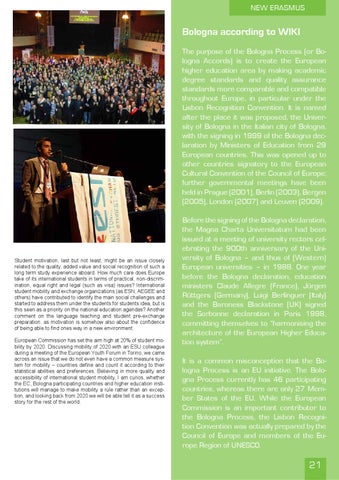new erasmus
Bologna according to WIKI The purpose of the Bologna Process (or Bologna Accords) is to create the European higher education area by making academic degree standards and quality assurance standards more comparable and compatible throughout Europe, in particular under the Lisbon Recognition Convention. It is named after the place it was proposed, the University of Bologna in the Italian city of Bologna, with the signing in 1999 of the Bologna declaration by Ministers of Education from 29 European countries. This was opened up to other countries signatory to the European Cultural Convention of the Council of Europe; further governmental meetings have been held in Prague (2001), Berlin (2003), Bergen (2005), London (2007) and Leuven (2009).
Student motivation, last but not least, might be an issue closely related to the quality, added value and social recognition of such a long term study experience aboard. How much care does Europe take of its international students in terms of practical, non-discrimination, equal right and legal (such as visa) issues? International student mobility and exchange organizations (as ESN, AEGEE and others) have contributed to identify the main social challenges and started to address them under the students for students idea, but is this seen as a priority on the national education agendas? Another comment on the language teaching and student pre-exchange preparation, as motivation is somehow also about the confidence of being able to find ones way in a new environment. European Commission has set the aim high at 20% of student mobility by 2020. Discussing mobility of 2020 with an ESU colleague during a meeting of the European Youth Forum in Torino, we came across an issue that we do not even have a common measure system for mobility – countries define and count it according to their statistical abilities and preferences. Believing in more quality and accessibility of international student mobility, I am curios, whether the EC, Bologna participating countries and higher education institutions will manage to make mobility a rule rather than an exception, and looking back from 2020 we will be able tell it as a success story for the rest of the world.
Before the signing of the Bologna declaration, the Magna Charta Universitatum had been issued at a meeting of university rectors celebrating the 900th anniversary of the University of Bologna – and thus of (Western) European universities – in 1988. One year before the Bologna declaration, education ministers Claude Allegre (France), Jürgen Rüttgers (Germany), Luigi Berlinguer (Italy) and the Baroness Blackstone (UK) signed the Sorbonne declaration in Paris 1998, committing themselves to “harmonising the architecture of the European Higher Education system”. It is a common misconception that the Bologna Process is an EU initiative. The Bologna Process currently has 46 participating countries, whereas there are only 27 Member States of the EU. While the European Commission is an important contributor to the Bologna Process, the Lisbon Recognition Convention was actually prepared by the Council of Europe and members of the Europe Region of UNESCO.
21
